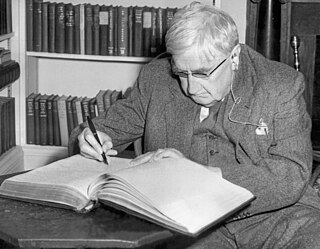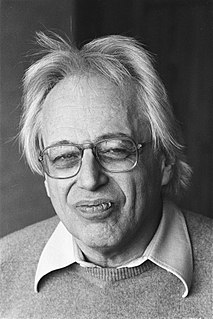Sources
- ↑ Michael Kurtz, Malcolm Hamrick Brown, and Christoph K. Lohmann (2007). Sofia Gubaidulina, p.232. ISBN 978-0-253-34907-1.
Music for Flute, Strings, and Percussion is a piece written by Sofia Gubaidulina in 1994 dedicated to Pierre-Yves Artaud.
The instruments are divided into two sections, one of which is tuned a quarter-tone lower than the other. [1] Gubaidulina (2001) describes, "in this way the potential of treating both halves as 'light' and 'shadow' emerges."[ citation needed ] She uses three chords, one major, one minor, and one whose third is exactly halfway between ("this triad possesses architectural significance, but also a symbolic meaning") being used at importance cadence points also determined by the five open strings of the higher orchestra section. The flute is in tune with this higher section, but through microintervals and glissandos also coincides with the lower section.
The piece has been recorded and released on:

The double bass, also known simply as the bass, is the largest and lowest-pitched bowed string instrument in the modern symphony orchestra. Similar in structure to the cello, it has four, although occasionally five, strings.

Orchestration is the study or practice of writing music for an orchestra or of adapting music composed for another medium for an orchestra. Also called "instrumentation", orchestration is the assignment of different instruments to play the different parts of a musical work. For example, a work for solo piano could be adapted and orchestrated so that an orchestra could perform the piece, or a concert band piece could be orchestrated for a symphony orchestra.
The Pomp and Circumstance Marches, Op. 39, are a series of five marches for orchestra composed by Sir Edward Elgar. The first four were published between 1901 and 1907, when Elgar was in his forties; the fifth was published in 1930, a few years before his death; and a sixth, compiled posthumously from sketches, was published in 1956 and in 2005–2006. They include some of Elgar's best-known compositions.

Capriccio espagnol, Op. 34, is the common Western title for a five movement orchestral suite, based on Spanish folk melodies, composed by the Russian composer Nikolai Rimsky-Korsakov in 1887. It received its premier on 31 October 1887, in St. Petersburg, performed by the Imperial Orchestra conducted by the composer. Rimsky-Korsakov originally intended to write the work for a solo violin with orchestra, but later decided that a purely orchestral work would do better justice to the lively melodies. The Russian title is Каприччио на испанские темы.

Sofia Asgatovna Gubaidulina is a Soviet-Russian composer and an established international figure. Major orchestras around the world have commissioned and performed her works. She is considered one of the foremost Russian composers of the second half of the 20th century.
The Cello Concerto No. 1 in E-flat major, Op. 107, was composed in 1959 by Dmitri Shostakovich. Shostakovich wrote the work for his friend Mstislav Rostropovich, who committed it to memory in four days and gave the premiere on October 4, 1959, with Yevgeny Mravinsky conducting the Leningrad Philharmonic Orchestra in the Large Hall of the Leningrad Conservatory. The first recording was made in two days following the premiere by Rostropovich and the Moscow Philharmonic, under the baton of Aleksandr Gauk.

David Geringas is a Lithuanian cellist and conductor who studied under Mstislav Rostropovich. In 1970 he won the gold medal at the International Tchaikovsky Competition. He also plays the baryton, a rare instrument associated with music of Joseph Haydn.
Camille Saint-Saëns composed his Cello Concerto No. 1 in A minor, Op. 33, in 1872, when he was 37 years old. He wrote this work for the Belgian cellist, viola da gamba player and instrument maker Auguste Tolbecque. Tolbecque was part of a distinguished family of musicians closely associated with the Société des Concerts du Conservatoire, France's leading concert society. The concerto was first performed on January 19, 1873, at the Paris Conservatoire concert with Tolbecque as soloist. This was considered a mark of Saint-Saëns' growing acceptance by the French musical establishment.
The Young Person's Guide to the Orchestra, Op. 34, is a 1945 musical composition by Benjamin Britten with a subtitle Variations and Fugue on a Theme of Purcell. It was based on the second movement, "Rondeau", of the Abdelazer suite. It was originally commissioned for the British educational documentary film called Instruments of the Orchestra released on 29 November 1946, directed by Muir Mathieson and featuring the London Symphony Orchestra conducted by Malcolm Sargent; Sargent also conducted the concert première on 15 October 1946 with the Liverpool Philharmonic in the Philharmonic Hall, Liverpool, England.

Sergei Prokofiev's Symphony No. 7 in C-sharp minor, Op. 131, was completed in 1952, the year before his death. It is his last symphony.

Ralph Vaughan Williams's Symphony No. 8 in D minor was composed between 1953 and 1955. Sir John Barbirolli, its dedicatee, conducted the Hallé Orchestra in the premiere at the Free Trade Hall in Manchester on 2 May 1956. It is the shortest of the composer's nine symphonies, and is mostly buoyant and optimistic in tone.

Alexander Kuzmich Vustin, also Voustin or Wustin was a Russian composer. His works, including the opera The Devil in Love, were played and recorded internationally.

The Concerto for Violin and Orchestra by György Ligeti is a violin concerto written for and dedicated to the violinist Saschko Gawriloff. A performance of the work lasts about 28 minutes.
Sur le même accord is a piece by the French composer Henri Dutilleux for solo violin and orchestra. It was composed for the violinist Anne-Sophie Mutter, and was premiered by her on 28 April 2002 in London with the London Philharmonic Orchestra conducted by Kurt Masur. The piece lasts about 10 minutes in performance.
Metropolis Symphony for Orchestra (1988–93) by American composer Michael Daugherty is a five-movement symphony inspired by Superman comics. The entire piece was created over the span of five years with separate commissions for each movement. Individual movements may be performed separately; however, it is preferred that the 41 minute symphony be performed in its entirety. MetropolisSymphony was premiered by the Baltimore Symphony Orchestra, David Zinman conducting, in January 1994, at the Meyerhoff Concert Hall in Baltimore, Maryland.
The BBC Radio Orchestra was a broadcasting orchestra based in London, maintained by the British Broadcasting Corporation from 1964 until 1991.
The Canticle of the Sun (Sonnengesang) is a composition by Russian composer Sofia Gubaidulina written in 1997 and published by Hans Sikorski, it is based on the "Canticle of the Sun" by Saint Francis of Assisi and is dedicated to Mstislav Rostropovich for his seventieth birthday. Though the piece features a soloist and an ensemble, Gubaidulina does not consider it a cello concerto.
The Symphony No. 5, Washington Mosaics, Op. 57, is an orchestral composition by the Finnish composer Aulis Sallinen, who wrote the piece from 1984–85, revising the finale in 1987. The National Symphony Orchestra, the commissioning institution, premiered the work in 10 October 1985 at the Kennedy Center in Washington, D.C., under the direction of its music director, Mstislav Rostropovich.

The Concerto no. 4 for Violin and Orchestra is a violin concerto by Soviet and German composer Alfred Schnittke. It was commissioned by the 34th Berlin Festival and written in 1984. Its first performance was given in Berlin on 11 September 1984 with dedicatee Gidon Kremer as soloist and the Berlin Philharmonic Orchestra conducted by Christoph von Dohnányi.